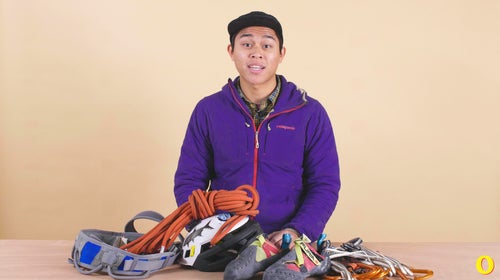Quality climbing equipment is built to last and keep you safe. But with time and use, even the most bomber piece of gear can become a safety hazard. The key to getting the most out of your kit is consistent inspection. We spoke to American Mountain Guides Association–certified rock guide Cody Bradford for his tips on knowing when it’s time to replace your gear.
Ropes
There are a few obvious signs that your rope is unsafe to use. First, look at the sheath—the outer material. Feel for any inconsistencies, like flat sections (which signal that the core is weak), frays, discoloration, or soft spots. Ideally, you should do this scan each time you flake your rope before a climb. If these marks reveal the core, the interior strands underneath the sheath, then that section is no longer safe to climb on. But if these spots appear toward the ends, it’s safe to cut off the damaged sections and still climb on the rest of the rope, Bradford explains. Just be sure you know how long it is for rappels and long routes.
Smaller, superficial marks, such as tiny chafes to the sheath, can be caused by drag. A rope is likely safe to use unless it’s soft and can be pinched into a sharp angle (a sound rope should bend in a smooth U shape), Bradford says, which would reflect damage to the core.
Judging integrity becomes harder when there are no visible marks or signs to indicate wear. “If a rope isn’t showing obvious signs [of wear], there are other things to look for. Consider questions like: When did you buy this rope? What has been its life span? How was it stored?’’ Bradford says. “Sometimes the rope will show all other signs of being in fine condition, but that can still raise yellow flags for me. An older rope—even one that is stored properly—is not going to live up to all of its intended strength specifications. It’s not going to have the qualities that it originally had.” This could present a safety risk, Bradford says.
As a general rule of thumb, you should replace your rope after a significant fall and inspect it for inconsistencies after a fall of any size. Climbers use the fall-factor ratio to rate severity: the higher the number, the more likely there will be damage to the rope. Since every fall can vary, I asked Bradford to get more specific. “Falls that would lead me to really inspect the rope are any kind that caused significant abrasion. If you take a fall and suddenly realize that there’s an abrasion that wasn’t there before, and you feel those soft spots, then the fall probably did some type of internal damage, and you may want to consider chopping that rope.”
But a big whipper isn’t the only sign that your rope should be replaced. “If it was a particularly hard or short fall that really rattled you, as the climber or the belayer, that’s a really good time to inspect and make sure none of that damage was incurred,” he says. If the rope was damaged, Bradford then weighs whether to cut the end off or retire the whole rope.
If you mainly use your rope in the gym, it will likely have a longer life span. “If all you’re doing is top roping, and it has no obvious abrasions that are starting to really wear down the sheath, there’s just no reason it can’t go all the way up to the manufacturer’s recommended timeline for moderate use,” he says.
Also consider general wear and tear: Bradford says that if you use your rope more than three to four times a week, you should retire it within a year. Replace one that’s mainly used on the weekends after one and a half to two years. If you only use it occasionally, consider getting a new one after three to five years, since the rope’s organic material can deteriorate over time.
Carabiners and Quickdraws
When I was racking up for a climb years ago, I asked my friend for an extra locking carabiner. He tossed it to me, but it soared over my head and fell to a rock ledge below us with a metallic ping. Though we couldn’t see any visible marks, we knew it was five years old and assumed the drop could have caused interior damage. We decided to retire it. After talking to Bradford, I learned—to my surprise—that it was most likely still safe to climb on.
“Microfractures are far less of a problem, both in real research that’s been done as well as in my own professional opinion. And they’re somewhat a ghost of the past,” he says. That’s because of the difference between aluminum and steel, he explains: “Aluminum is a soft metal. And almost all of the [metal] equipment that we use now that is not permanent hardware, [like bolts] on a climb or in a gym, is aluminum, because it’s easy to use and lightweight. It also accepts damage really well. Steel doesn’t bend as much, it doesn’t react as well to impact. When steel hits a rock, it can crack much more.” It’s important to remember that steel carabiners still exist, and each drop should warrant a thorough inspection.
No matter the material, look for any visible cracks or deformities in the shape of the carabiner. If the gate cannot open and close correctly, or if it appears to be bent or damaged, do not use it. The same applies to locking versions: if the mechanism can’t function correctly, then put the carabiner out of commission.
What about that old box of ’biners that’s been sitting in your basement? “Carabiners and metal objects like buckles have no set life span in an environment they are recommended for, where they’re just sitting. Theoretically, you could use a Chouinard piece that’s 40 years old, if it’s been sitting in a duffel bag in a dry environment out of the sun,” he explains.
When inspecting your quickdraws, take a look at the dogbones—the webbing that connects the two carabiners. Check them like you would a rope or harness, since the material is similar (nylon or polyethylene). The life of this connector is largely dependent on the elements it’s exposed to: rock abrasion, precipitation or moisture, and the sun, Bradford says. Watch for fraying or cuts that would weaken the strength of the draw. Some companies include indicators inside the webbing to signal when it’s time for a replacement.
Harnesses
Much like climbing rope, harnesses should be examined frequently. Check for frays in the fabric or tears in the stitching, especially if you spot these signs on the belay loop. Are there any cuts or rips in the general construction, such as in the waist belt or leg loops? Do any buckles appear to be damaged or cracked? If yes, then it’s time to replace it.
If there are no visible signs of wear, take into account how often you use your harness. If you climb in it every day, consider retiring it after a year to two years. “The longest I’ve ever kept a harness is two years,” Bradford says. He rotates through a quiver both at the gym and while guiding to spread out their life spans.
Less frequent usage, such as on most weekends, means it should last about five years, Bradford says. Like the nylon in ropes, the fabric can deteriorate with time and exposure to the elements. A harness that is stored properly (away from the sun, in a cool, dry environment) will have a longer life span.
Helmets
Helmets generally last longer than ropes and harnesses. You should retire yours if it suffers any severe damage, such as a big impact on the wall or significant rockfall that compromises its integrity. Most will collect small dings and scratches from general use. But big depressions or dents in the shell mean it’s time to get a new one. If it hasn’t been majorly damaged, consider replacing it after five to eight years, Bradford says, depending on how often you use it.
When Bradford inspects his clients’ headgear, he asks himself: Does the buckle function properly? Is the webbing inside the helmet visible and able to be inspected for inconsistencies? If a client has an older model, and he’s taking them into the mountains where rockfall, gear fall, and personal danger is more likely, then he will have them use a different helmet—he’s not willing to risk their safety when he can provide them with a newer model that has likely taken less impact.
Shoes
Compared to the rest of the gear on this list, climbing shoes are the least crucial to your safety on the rock. But with frequent use, the rubber soles will wear out and become ineffective. Look at the rubber’s edge: Is it round, smooth, or dull? Is the sole slippery as a whole? If the answer to either of these questions is yes, it’s likely time to replace them. The good thing about climbing shoes is they can often be resoled for a fee by sending them back to the manufacturer or to an independent resoler. “It’s way better to spend 60 bucks on a resole than another $180 on a new pair of TC Pros,” Bradford says.

